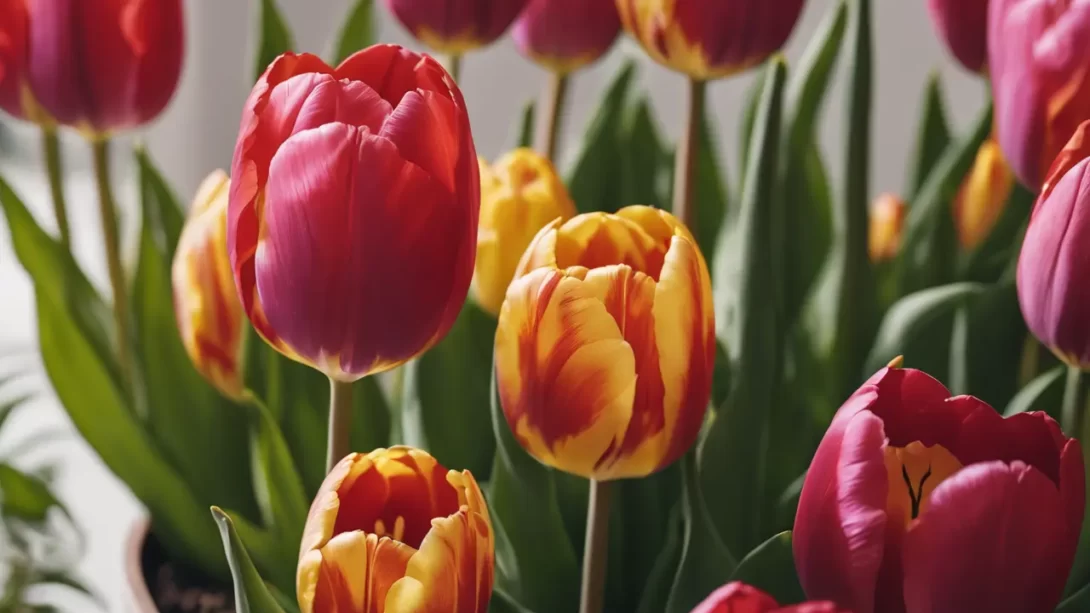Tulips, with their vibrant colors and elegant shapes, are a beloved choice for gardeners and flower enthusiasts. When grown in pots, these spring-blooming bulbs can add a splash of color to patios, balconies, and indoor spaces. Caring for potted tulips involves specific considerations to ensure they thrive and bloom beautifully. This article provides a comprehensive guide on how to care for tulips in pots, covering everything from planting to post-bloom care.
Choosing the Right Pot and Soil
Selecting the appropriate pot and soil is crucial for the health of potted tulips. The pot should have adequate drainage holes to prevent waterlogging, which can cause bulb rot. A depth of at least 8-10 inches is ideal to accommodate the bulb and allow room for root growth. As for the soil, tulips prefer well-draining, fertile soil. A mix of potting soil with some added compost or well-rotted manure provides the right balance of drainage and nutrients.
Planting Tulip Bulbs
Planting tulip bulbs in pots is straightforward, but there are a few key points to ensure success:
- Timing: Plant tulip bulbs in the fall, about 6-8 weeks before a hard frost is expected.
- Depth and Spacing: Plant the bulbs about three times their height in depth and space them a few inches apart. The pointed end of the bulb should face upwards.
- Layering Bulbs: For a fuller display, consider layering bulbs at different depths in the same pot.
- Initial Watering: After planting, water the bulbs thoroughly to settle the soil around them.
Light and Temperature Requirements
Light and temperature are pivotal in the growth and blooming of tulips. These plants thrive in a location that receives full to partial sunlight. Ideal temperatures for tulip growth range from 55 to 65 degrees Fahrenheit during the day, slightly cooler at night. If you’re growing tulips indoors, ensure they receive enough light, either through natural sunlight or using grow lights.
Watering Potted Tulips
Watering is a critical aspect of tulip care. The soil should be kept evenly moist but not waterlogged. Overwatering can lead to bulb rot, a common problem in potted tulips. During the growing season, water the tulips when the top inch of soil feels dry to the touch. Reduce watering once the blooms have faded and the leaves begin to yellow, signaling the end of the growing season. Ensure good drainage in the pot to prevent excess water from accumulating around the roots.
Fertilizing and Feeding
Fertilization is important for the health and blooming of tulips. Use a balanced, slow-release fertilizer when planting the bulbs, and then again when the shoots begin to emerge in spring. Avoid high-nitrogen fertilizers, as they can encourage leaf growth at the expense of flowers. A low-nitrogen, high-potassium fertilizer is ideal for encouraging vibrant blooms. Follow the instructions on the fertilizer package for proper application and dosage.
Post-Blooming Care
After tulips have bloomed, their care should not be neglected. Continue to water and fertilize the plant as the leaves remain green. This post-blooming period is crucial for the bulbs to store energy for the next flowering season. Once the foliage has yellowed and died back, you can reduce watering. At this point, you can also remove the spent flowers and foliage. If you plan to reuse the bulbs, store them in a cool, dry place until the next planting season.
Dealing with Pests and Diseases
Tulips in pots can be susceptible to pests and diseases, such as aphids, bulb mites, and fungal infections like tulip fire. Regularly inspect your plants for signs of trouble and treat problems promptly. Neem oil or insecticidal soap can be effective against common pests. To prevent fungal diseases, avoid overhead watering and ensure good air circulation around the plants. Remove and discard any affected plant parts to prevent the spread of disease.
Winter Care for Potted Tulips
In colder climates, special care is needed to protect potted tulips during winter. Unlike bulbs planted in the ground, those in pots are more susceptible to freezing temperatures. Here are some strategies for overwintering your tulip bulbs:
- Insulation: Wrap the pot in bubble wrap or burlap to provide insulation. This helps to prevent the soil and bulbs from freezing.
- Location: Move the pots to a sheltered location, such as against a house wall or inside an unheated garage or shed, where they remain cold but are protected from extreme temperatures.
- Mulching: Apply a layer of mulch on top of the soil in the pot. This adds extra insulation and helps to regulate soil temperature.
- Watering: Reduce watering significantly during winter, as the bulbs are dormant and excess moisture can lead to rot.
Replanting and Rotation
After a few years, tulip bulbs in pots may lose vigor and produce smaller blooms. It’s a good practice to replace the bulbs every two or three years to maintain a vibrant display. You can also rotate different bulb varieties each year to enjoy a variety of colors and bloom times.
Environmental Considerations
Tulips in pots can be susceptible to environmental stress. Protect the pots from strong winds, which can damage the plants. In regions with very hot summers, consider moving the pots to a location with afternoon shade to prevent overheating.
Conclusion
Caring for potted tulips requires attention to detail, especially regarding watering, fertilizing, and winter protection. By following these guidelines, you can enjoy the stunning blooms of tulips each spring. Whether displayed on a patio, balcony, or indoors, tulips in pots can be a spectacular addition to your gardening space, bringing a touch of springtime beauty wherever they are placed. With proper care, these elegant bulbs will flourish year after year, brightening your home with their vibrant colors and graceful forms.



